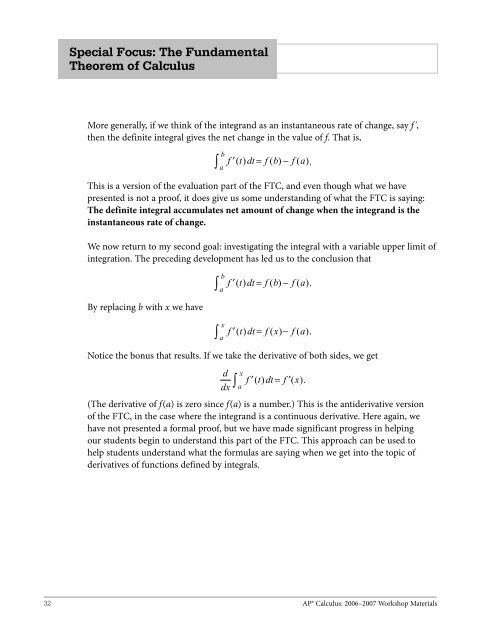AP Calculus
Calculus_SF_Theorem
Calculus_SF_Theorem
You also want an ePaper? Increase the reach of your titles
YUMPU automatically turns print PDFs into web optimized ePapers that Google loves.
Special Focus: The Fundamental<br />
Theorem of <strong>Calculus</strong><br />
More generally, if we think of the integrand as an instantaneous rate of change, say f',<br />
then the definite integral gives the net change in the value of f. That is,<br />
b<br />
∫ f ′( t) dt = f ( b) − f ( a).<br />
a<br />
This is a version of the evaluation part of the FTC, and even though what we have<br />
presented is not a proof, it does give us some understanding of what the FTC is saying:<br />
The definite integral accumulates net amount of change when the integrand is the<br />
instantaneous rate of change.<br />
We now return to my second goal: investigating the integral with a variable upper limit of<br />
integration. The preceding development has led us to the conclusion that<br />
By replacing b with x we have<br />
b<br />
∫ f ′( t) dt = f ( b) − f ( a).<br />
a<br />
x<br />
∫ f ′( t) dt = f ( x) − f ( a).<br />
a<br />
Notice the bonus that results. If we take the derivative of both sides, we get<br />
d<br />
dx<br />
x<br />
∫ f ′( t) dt = f ′( x).<br />
a<br />
(The derivative of f(a) is zero since f(a) is a number.) This is the antiderivative version<br />
of the FTC, in the case where the integrand is a continuous derivative. Here again, we<br />
have not presented a formal proof, but we have made significant progress in helping<br />
our students begin to understand this part of the FTC. This approach can be used to<br />
help students understand what the formulas are saying when we get into the topic of<br />
derivatives of functions defined by integrals.<br />
32<br />
<strong>AP</strong>® <strong>Calculus</strong>: 2006–2007 Workshop Materials


